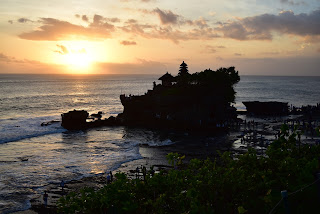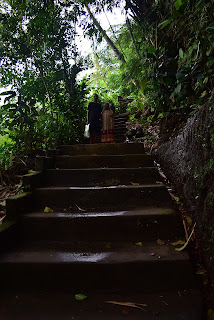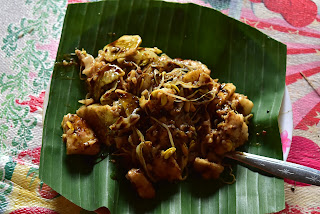Part I - CLICK HERE
Gitgit waterfall, Pura Beji, Pura Ulun Batur and Besakih temple
Gitgit Waterfall, a beautiful tourist destination in north part of
Pura Beji was our next destination and I had the most
profound divine and energy experience there. The energy was deep, sharp and
penetrating. It is a temple rarely visited by tourists. It is located in the
north of Bali in Sangsit around eight
kilometres east of Singaraja. The temple was built of easily carvable soft pink
sandstone and its walls are decorated with sculptures of snakes, demons, and
devils.
Pura Beji is dedicated to Dewi Sri, goddess of agriculture.
Dewi Sri, or Shridevi, the goddess of rice
and fertility, is widely worshipped on the islands of Bali
and Java. The goddess is associated with the Hindu goddess Lakshmi as both are
attributed to wealth and family prosperity.
Pura Ulun Danu Batur is the second most important
temple in Bali , after Pura Besakih. Built in
1926, the temple is dedicated to Dewi Danu, goddess of lakes and rivers.
"Ulun Danu" literally translates as "head of the lake".
Originally, Pura Batur and the village
of Batur were located down in the
caldera at the foot of Mount
Batur
After the temple visit we had an awesome buffet lunch in a
hotel with a view of the Batur volcano.
Next we moved on to the Besakih temple. Pura Besakih is a temple complex in thevillage
of Besakih on the slopes of Mount Agung
in eastern Bali .
It is the most important, the largest and holiesttemple of Hindu religion in Bali ,
and one of a series of Balinese temples. Perched nearly 1000 meters up the side
of Gunung Agung, it is an extensive complex of 23 separate but related temples
with the largest and most important being Pura Penataran Agung. The temple is
built on six levels, terraced up the slope.
Next we moved on to the Besakih temple. Pura Besakih is a temple complex in the
It is the most important, the largest and holiest
Luckily a sadhu explained facts about the temple to us and
showed us the Brahma, Vishnu, Shiva, Durga and Lakshmi idols.
Snorkeling - beyond words
A whole morning, evening and the next day morning were spent
in snorkeling at the Amed beach, which was a unique experience. Shoals of fish,
small and big, in myriads of colors, and the corals all around us, it was
really a dream world. The floor was covered with black and white pebbles and we
saw a fish with matching colors. Periodically it was changing its position;
only from its movement we realized it was a fish.
We met a tourist who told he has traveled half the world and
had done snorkeling in famous locations, and he told Amed ranks first!
We stayed at the Dillons hotel.
At night I heard weird sounds, resembling loud croaking of frog or sound of a bird. I felt as if the sound was coming from below my bed, and was a bit scared. My husband got up and examined the room and assured me there was nothing in the room so that I could sleep.
At night I heard weird sounds, resembling loud croaking of frog or sound of a bird. I felt as if the sound was coming from below my bed, and was a bit scared. My husband got up and examined the room and assured me there was nothing in the room so that I could sleep.
One day we got up at 4.30 am and meditated sitting next to
the sea. It was such a calming and divine experience!
Pura Penataran Agung Lempuyang
Pura Penataran Agung Lempuyang,or Lempuyang
Temple is one of Bali ’s
oldest and most highly regarded temples, on par with Besakih. It is also
believed to predate the majority of Hindu temples on the island. Definitely a
highlight on any travel itinerary for the fit and adventurous, the main temple
lies at 1,175m above sea level, up on the peak of the namesake Mount Lempuyang
in East Bali .
The heights are reachable via a steep staircase of over
1,700 steps, with attractions along the way including several other temples. We
didn’t climb all the way up, but could see the silhouette of the main temple
after climbing a reasonable distance, and I could feel the expansive energy
around me.
A visit to Tirta Gangga
Tirta Gangga is a former royal palace in eastern Bali , Indonesia Ganges and it is a site of some
reverence for the Hindu Balinese.
Strictly, the name refers to the water palace built in 1948
by the Raja of Karangasem, Anak Agung Agung Anglurah Ketut Karangasem. It is,
however, the name widely used to refer to the general area which includes the
water palace and the lush rural areas around. Tirta Gangga water palace is a
maze of pools and fountains surrounded by a lush garden and stone carvings and
statues.
The centerpiece of the palace is an eleven tiered fountain. The
area around Tirta Gangga is noted for its rice paddy terraces.
Leaving Padang
Bai for Ubud
We moved on to Padang Bai, thinking of halting there. But it
was too crowded and the people were not as friendly as we had experienced so
far. Padangbai is a small town in eastern Bali ,
near Candidasa. It serves as a ferry port for travel to Lembar on Lombok, The
Gilis and other of the Lesser Sunda Islands .
Besides the beach near the ferry terminal there is a beach just to the north
known locally as the Blue Lagoon.
The Blue
Lagoon Beach
The beach is clean and water is quite clear so it’s easy to see what’s underneath. Blue Lagoon is a great beach for snorkeling. The coral reef is right up to the shore and is very pretty.
The beach is clean and water is quite clear so it’s easy to see what’s underneath. Blue Lagoon is a great beach for snorkeling. The coral reef is right up to the shore and is very pretty.
Instead of staying in Padang Bai, we went to Ubud and after
a hectic search, got a beautiful place, ‘Semujan Bungalow’ to stay.
Its owner, Ms. Agung, a great devotee of Shiva, was a very friendly lady. And she invited us to attend the Kunningan ceremony in her house. We reached there in the morning and saw the extensive preparations made for the ceremony.
Being Hindus, we were allowed to pray in their family temple, and we prayed for our ancestors. EveryBali house has a temple,
which will be more elaborate in large families. Every day offerings are made
thrice a day in the temple. All Bali villages
have two temples.
Its owner, Ms. Agung, a great devotee of Shiva, was a very friendly lady. And she invited us to attend the Kunningan ceremony in her house. We reached there in the morning and saw the extensive preparations made for the ceremony.
Being Hindus, we were allowed to pray in their family temple, and we prayed for our ancestors. Every
A massage before leaving
While walking through the streets in Ubud we located a
massage center, ‘Tirta Wangi Spa’. We went inside, liked the ambiance very
much, and fixed appointment for Balinese massage and Boreh scrub on the day
before our flight back.
Boreh Bali is a traditional Balinese Body Mask that warms
the body, opens the pores and improves circulation, promoting relaxation and
the release of toxins while revitalizing the skin cells and exfoliating the
skin, cleaning, replenishing and rejuvenating resulting in a fresher, smoother
more refined appearance and an increased feeling of energy, clarity, relaxation
and well being. And what an experience it was! I felt cleansed and rejuvenated.












































